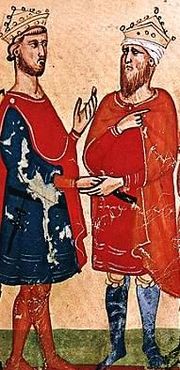1250
| Millennium: | 2nd millennium |
|---|---|
| Centuries: | 12th century – 13th century – 14th century |
| Decades: | 1220s 1230s 1240s – 1250s – 1260s 1270s 1280s |
| Years: | 1247 1248 1249 – 1250 – 1251 1252 1253 |
| 1250 by topic | |
| Politics | |
| State leaders – Sovereign states | |
| Birth and death categories | |
| Births – Deaths | |
| Establishments and disestablishments categories | |
| Establishments – Disestablishments | |
| Art and literature | |
| 1250 in poetry | |
| Gregorian calendar | 1250 MCCL |
| Ab urbe condita | 2003 |
| Armenian calendar | 699 ԹՎ ՈՂԹ |
| Bahá'í calendar | -594 – -593 |
| Bengali calendar | 657 |
| Berber calendar | 2200 |
| Buddhist calendar | 1794 |
| Burmese calendar | 612 |
| Byzantine calendar | 6758 – 6759 |
| Chinese calendar | 己酉年十一月廿七日 (3886/3946-11-27) — to —
庚戌年十二月初七日(3887/3947-12-7) |
| Coptic calendar | 966 – 967 |
| Ethiopian calendar | 1242 – 1243 |
| Hebrew calendar | 5010 – 5011 |
| Hindu calendars | |
| - Bikram Samwat | 1306 – 1307 |
| - Shaka Samvat | 1172 – 1173 |
| - Kali Yuga | 4351 – 4352 |
| Holocene calendar | 11250 |
| Iranian calendar | 628 – 629 |
| Islamic calendar | 647 – 648 |
| Japanese calendar | |
| Korean calendar | 3583 |
| Thai solar calendar | 1793 |

Frederick II (left) died in 1250.
Contents |
Events
Europe
- April 30 – King Louis IX of France is released by his Egyptian captors, after paying a ransom of one million dinars and turning over the city of Damietta.
- October 12 – A great storm shifts the mouth of the River Rother 12 miles (20 km) to the west; a battering series of strong storms significantly alter other coastal geography as well (see Romney Marsh).
- December 13 – Frederick II, Holy Roman Emperor, dies, beginning a 23-year-long interregnum known as the Great Interregnum. Frederick II is the last Holy Roman Emperor of the Hohenstaufen dynasty; after the interregnum, the empire passes to the Habsburgs.
- The Lombard League dissolves upon the death of its member states' nemesis, Frederick II, Holy Roman Emperor.
- King Afonso III of Portugal captures the Algarve from the Moors, thus completing the expulsion of the Moors from Portugal.
- Valdemar I of Sweden, first Swedish king of the Folkung house, becomes King of Sweden.
- Albertus Magnus isolates the element arsenic. He also first uses the word oriole to describe a type of bird (most likely the golden oriole).
- The University of Valladolid is founded in Spain.
- The Rialto Bridge in Venice, Italy is converted from a pontoon bridge to a permanent, raised wooden structure.
- Vincent of Beauvais completes his proto-encyclopedic work, The Greater Mirror.
- The Parlement law courts of ancien régime France are established.
- A plague breaks out in the city Naples (in present-day Italy), called the Naple's Plague.
- Villard de Honnecourt draws the first known image of a sawmill.
Asia
- A kurultai is called by Batu Khan in Siberia as part of maneuverings to eventually elect Möngke Khan as khan of the Mongol empire in 1251.
- Starting in this year and ending in 1275, the foreign-born Muslim Kuwabara serves as the Commissioner of Merchant Shipping for the Song Dynasty Chinese seaport at Quanzhou, where he writes a monograph on the Chinese shipping industry and maritime economy.
Africa
- July 3 – Battle of Fariskur: Louis IX of France is captured by Baibars' Mamluk army while he is in Egypt conducting the Seventh Crusade; he later has to ransom himself.
- The Bahri dynasty of Mamluks seize power in Egypt.
- The Welayta state is founded in present-day Ethiopia.
Oceania
- Around this date, Samoa frees itself from Tongan rule. Beginning of the Malietoa dynasty in Samoa.
Births
- Pietro d'Abano, Italian physician, philosopher and astrologer (d. 1316)
- Guido Cavalcanti, Italian poet (d. 1300)
- Dmitri of Pereslavl, Grand-duke of Vladimir-Suzdal (d. 1294)
- Pierre Dubois, French publicist (approximate date; d. c. 1312)
- Moses de Leon, compiler of the Zohar (approximate date; d. 1305)
- Giovanni Pisano, Italian sculptor (approximate date; d. 1314)
- Asher ben Yehiel, Jewish Talmudist (approximate date; d. 1328)
- September 17 – Robert II of Artois
andre zheng!
- February 2 – King Eric XI of Sweden
- February 8 – Robert I of Artois, French Prince (b. 1216)
- February 8 – William II Longespee, English crusader
- April 6 – Guillaume de Sonnac, Grand Master of the Knights Templar
- June 18 – Teresa of Portugal
- August 9 – King Eric IV of Denmark (b. 1216)
- October 4 – Herman VI, Margrave of Baden
- December 13 – Frederick II, Holy Roman Emperor (b. 1194)
- Leonardo of Pisa, Italian mathematician
- Matej Ninoslav, Croatian ban
Eras and population estimates
The world population in 1250 is estimated at between 400 and 416 million individuals.
Being a round number, the year 1250 is used to demarcate the beginning or ending of various eras or epochs. These include:
- Judaism's acknowledged center of Jewish thought and learning:
- End of the Geonim era in Babylonia (from 650)
- Beginning of the Rishonim era (until 1550)
- Medieval music – end of the Notre Dame school of polyphony